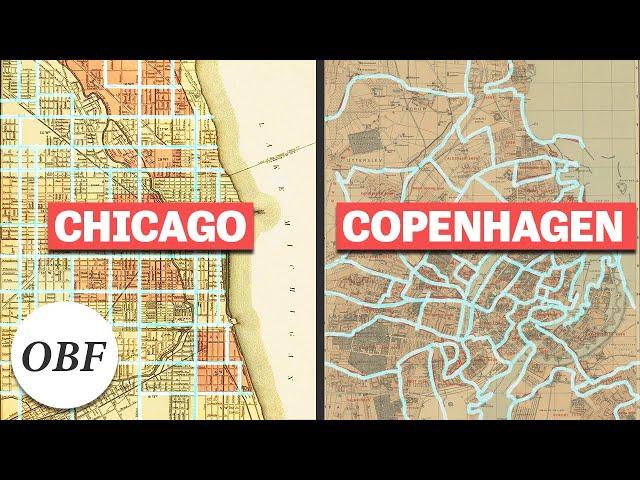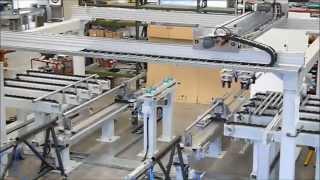Комментарии:

Chicago may look lame on a map but it is extremely easy to navigate and surprisingly walkable. The real problem with American cities is the dominance of cars.
Ответить
班代表:
為何格狀城市設計會使城市變得糟糕
在全球的城市規劃中,格狀設計(Grid Design)一度被認為是最有效率的街道規劃方式。然而,隨著時代的變遷,這種設計在現代城市生活中的弊端也逐漸浮現。尤其是在汽車的普及後,格狀設計所帶來的交通管理、環境可持續性等問題,讓人不得不重新審視這種曾經被廣泛推崇的規劃方式。
格狀設計的普及與問題
芝加哥被評為格狀設計最成功的城市,得分高達 0.899,這也象徵著它的街道最接近理想中的完美網格。這種設計簡單、直觀,便於土地劃分與未來擴展,尤其是在 19 世紀末至 20 世紀初,隨著大量來自歐洲的移民進入美國,這種設計方式在規劃快速成長的城市中取得了經濟上的成功。然而,隨著汽車的崛起,這種設計的缺陷開始暴露。
交通管理與安全問題
最顯著的問題在於格狀設計未能有效區分主要交通幹道與住宅街道。所有街道都非常相似,這使得部分街道無法有效承載大量車輛流量,進而導致交通擁堵和交通事故的增加。交叉口的頻繁出現更是加劇了這一問題,這些地方通常是交通事故的高發區域。
環境問題與可持續性挑戰
格狀設計還有另一個隱藏的問題,即它對環境的負面影響。這種設計的剛性使得城市規劃無法靈活適應地形的變化,往往需要大規模平整土地,進一步破壞自然景觀。此外,格狀設計所需的大量鋪裝地面(如混凝土和瀝青)降低了土壤的透水性,導致排水問題和水文危機的潛在風險。 此外,最近的研究還顯示,格狀設計的直角街道會干擾空氣流通,進而困住熱量,使得城市的熱島效應更加嚴重。在佛羅里達州,這一現象每年帶來的空調費用損失高達 4 億美元。
美學問題與心理健康
令人驚訝的是,格狀設計還被批評為單調無趣,這種缺乏變化的設計被認為對城市美學有負面影響。隨著時間的推移,這種乏味的環境可能會對市民的心理健康產生不良影響,增加焦慮或壓力。
前景展望:適應與創新
儘管格狀設計存在諸多問題,但它並非全然無用。巴塞羅那就是一個成功的範例,該市通過創新規劃和設計,將格狀街道融入更符合現代需求的城市架構中,實現了環境可持續性和城市生活的提升。 未來的城市發展不必完全放棄格狀設計,而是應該根據當前的需求進行適應與改進。通過更加靈活、創新的城市規劃,我們或許可以發揮格狀設計的優勢,同時解決它所帶來的種種問題,為未來的城市生活鋪平道路。 總結來說,格狀設計的問題揭示了城市規劃中需要更多的思考與創新,只有當設計能夠順應時代變遷,才能真正達到可持續發展的目標。

Its better than NYC
Ответить
the 3 most grided cities in U.S. are all in relatively flat topo areas
Ответить
Maybe the problem is not the zoning, but what is included in this zoning? Barcelona looks great with grids and low-rise buildings and an abundance of greenery. Non-grid zoning is unlikely to save American streets from overheating and stagnant emissions, because these streets are surrounded by huge boxes of glass and concrete with dominance of cars.
Ответить
Here's my thoughts. I had a roommate at USU that was from slovenia. He was getting his masters in city planning or something working on a project to make a more walkable or people friendly map for Odgen, Utah, I believe. I can't remember. Yes for people culturally used to walking and living in cities I suppose it makes sense to make cities walkable. But I'd argue one reason cities weren't designed that way was because of prices of real estate. Many people prefer to live further away from the city and travel to work. The cost of real estate or housing seems like it'd be cheaper or would promote more affordable housing if people could travel rather than rely on walking from home to their work. It's one reason lots of cities have literal commercial or industrial zones for businesses to build in. Sure they can build a warehouse or mechanic shop etc. in the center of a city, but I've seen many businesses be engulfed by real estate development eventually selling and moving the business to the edge of the city or out in the county. Now for high paying companies or whatever sure it doesn't matter. Big banks or law firms etc aren't going to leave the middle of a city. But many many jobs literally are forced out of a city especially if the company rents the land or building. Public transportation helps sure, but if you build a train system that's still not a walkable environment. In Utah for instance many people drive to parking lots by a train stop and then ride the train to the city. But you're not walking as you drive to the train parking lot and then you take the train. Even in the rural town I live in with a few massive companies that make guns or airplane wings theyre on the edge of town. If people were to walk they'd literally would have some walking three miles one way and that's not very livable if the temperature is 20-30 degrees for a few months or if it drops to zero for a few days. People aren't going to ride their bike either even if there is already low traffic. The city or town has zoning laws so the first block is commerical, but no large company builds on the first block as you can't expand. So large companies literally have to be on the edge of town.
Ответить
Grids were built for streetcars. It was to make easy use of streetcars. It was the most efficient design.
Ответить
Intersections are the spawn of sat@n. Roundabouts are sooo much better
Ответить
Americans: commie blocks are so boring and unoriginal!
Americsn city designs:

These blocks are like prison cells.
Ответить
You can make grids more people centered and less car dependent by shortening block sizes and narrowing street widths. The historic cores of Philly and New Orleans are charming and great for pedestrians and cyclists and hell for drivers, which I would consider a plus. Manhattan, perhaps the most walkable and transit served place in the world despite being in the US is almost entirely a grid north of 14th street. Most of Osaka, japans second largest city, is in a grid and I don’t think anyone would argue is unlivable. American cities are newer and thus were more planned, this also corresponds to American cities being centered around cars during the mid 1900s with the rise of automobile lobbies buying up and tearing up streetcar tracks and the rise of suburbanization and white flight after the post war housing crisis. This increased car dependency and car commuters driving into our cities, much of which became destroyed to build parking lots for said cars, is why American cities suck for people so much. Most american cities are car hellscapes on the bones of once pedestrian friendly and transit rich cities. The more you look into the history, the sadder it is. I recommend looking into the insta page segregation by design.
Ответить
This video is bs, grid system is literally the best.
Ответить
We’re forced to use cars to get around in the us… most of our public transportation sucks
Ответить
It could be something like this:
Grid cities are likely new
Older cities have their culture, trade district, city centre, night life more flushed out, and feel more home like.
Older cities also routinely lose the grid like structure.
We could be seeing that grid like cities can’t maintain their true shape over time as people will redevelop all the time

Love Chicago/ Copenhagen it's in order
Ответить
Saying that the livability of a city is based on the grid system is the same as saying that the reason young people aren't able to afford housing is because they don't choose the right degree or don't work hard enough. Faulty investigation
Ответить
Minneapolis, Vancouver, Seattle, Portland, and Denver, all of which routinely make appearances on global most livable cities indexes aren't livable, because they are on a grid?
Yeah, ok 👍

The city of Melbourne debunks the quality of life aspect as it is known as one of the most livable cities in the world, however in 2021 it was undergoing extreme lockdown measure depleting the quality of life
Ответить
My city have the lowest (São Paulo = 0.002)... whatapride! lol
The thing is: dense metropolitan areas suck by definition. The problem in São Paulo is not it's streets, but it's huge population and the land area. Traffic wouldn't be a problem if you work five minutes from your residence, but people have to travel more than 20km (a lot even more... way more).

Chicago=0.899
Miami 0.811
Minneapolis 0.749
Vancouver 0.749
Seattle 0.723
Portland 0.679
Denver 0.678
Manhattan 0.669
Phoenix 0.586
Detroit 0.582
Las Vegas 0.542
Cleveland 0.486
Orlando 0.481
Toronto 0.474
Houston 0.425
Washington 0.377
Mogadishu 0.375
Kyoto 0.357
Los Angeles 0.348
Melbourne 0.340
Beijing 0.335
Phnom Penh 0.324
Atlanta 0.315
Philadelphia 0.312
Dallas 0.305
Lima 0.278
San Francisco 0.278
St Louis 0.276
Osaka 0.243
Baltimore 0.223
Beirut 0.206
Montreal 0.204
Jakarta 0.167
Taipei 0.158
Mexico City 0.154
Buenos Aires 0.151
Tehran 0.137
New Orleans 0.123
Shanghai 0.121
Barcelona 0.108
Bangkok 0.105
Casablanca 0.094
Sydney 0.092
Karachi 0.088
Baghdad 0.083
Munich 0.078
Kabul 0.076
Mumbai 0.075
Amsterdam 0.071
Manila 0.062
New Delhi 0.062
Ulaanbaatar 0.058
Reykjavik 0.056
Kathmandu 0.054
Budapest 0.050
Tokyo 0.050
Vienna 0.050
Glasgow 0.047
Damascus 0.043
Athens 0.041
Cairo 0.041
Prague 0.049
Sarajevo 0.039
Bogota 0.040
Lagos 0.039
Warsaw 0.036
Honolulu 0.034
Dubai 0.031
Caracas 0.029
Copenhagen 0.029
Havana 0.029
Port au Prince 0.028
Boston 0.026
Cape Town 0.025
Dublin 0.024
Pyongyang 0.024
Lisbon 0.023
Johannesburg 0.019
Madrid 0.019
Pittsburgh 0.018
Venice 0.017
Paris 0.016
London 0.015
Jerusalem 0.014
Kiev 0.014
Nairobi 0.014
Rio de Janeiro 0.014
Hong Kong 0.012
Berlin 0.011
Hanoi 0.010
Seoul 0.009
Oslo 0.008
Istanbul 0.007
Moscow 0.007
Helsinki 0.006
Stockholm 0.006
Rome 0.005
Singapore 0.005
Charlotte 0.002
São Paulo 0.002

The only reason why US has so many grid cities is that US has no history. When city planners looked at the land there was literally nothing there. Grids are the simplest to plan. Boston is the most historical city in us, so there are not so many perfect grids. If you take a look at newly developed cities around the world, they use grids as well.
Ответить
This video is completely false as stated by others in the comments so i wont get into it.
Ответить
Grids are ugly
Ответить
Boring!
Ответить
american cities are deasigned for cars not humans
Ответить
I love living on a grid. If the blocks are big enough you get a quiet park in the middle for gardens, play grounds. I would leave it for anything.
Ответить
You should rename the video to 'How some grid designs are terrible'
Ответить
What about those closest to the 0 end of the spectrum? I feel like there is a sweet spot on the scale. The cities closest to 0 are some of the worst to get around i.e. Charlotte: .002
Ответить
What about Salt Lake City Lake? It’s a perfect grid.
Ответить
I prefer winding, organically-developed streets that "respect the topography" :P. I do think it's possible for grids to function well though, and be somewhat aesthetically pleasing, and that they're necessary at least for major roads in large cities. Regarding your history: some of the earliest settlements in North America had strict grids because enlightment or something. I think even in ancient Roman times it was the case. So it's not just a modern thing.
Ответить
Grids are not problem.
The problem is budget is not spent on clean pavement.😂

Rome vs Roman colonies
Ответить
Let's build some cool new, self sustaining, walkable towns - in harmony with nature.
Ответить
But vancouver is like top 5 in 2023 most liveable cities
Ответить
🦬
Ответить
Grid layouts are better because they are easier to get around in, streets with the heaviest traffic are evenly spaced making it easy to know where you are in the city. I prefer the grid layout because it is less confusing and more orderly.
Ответить
grids are for O'Neil cylinders
Ответить
GET GODZILLA'D TO THE BONE!
Ответить
EVs aren’t dominating the car market anytime soon lmao
Ответить
Bad video.
Yes, what you mention between livability and gridlines is a correlation. It's not food for thought.
I study a a lot of new urban city planning. The problem is not gridlines as a whole. But hte following:
1) Cities were not well designed for cars and high traffic.
2) You can still use gridlines but big blocks, less cars and better design of arteries and roads to deal with this.THere is plenty info about this in the internet
3) You can improve pedestrian sidewalks, public transport etc and traffic will be less
4) Airlfow: You can use wider avenues for that. Even circular streets can disrupt airflow.
Conclusion: Watch many other videos. The grid system has many advantages not mentioned in the video. But you need to desing cities according to the laws of new urbanism. It relies on bigger grids and more things like the ones I mentioned.

You said it in the video yourself, correlation does not imply causation. Grid cities might actually work, it is just a shame that all grid cities are in the US which is known by basically everyone to be very car centric and therefore very bad for walkability. You also said “So why did grid designs become so problematic? Cars.” You said that they are problematic because of an entirely different issue. Your other issues with the grid city design are also caused by cars, issues with traffic signals and the high frequency of intersections? If cars were not a factor, like they are in many other countries, you could have public transit, which has been proven to carry more than cars there instead of jamming everything up with cars. Your issue with asphalt could also be fixed if everyone was riding on trams with grassy tram tracks of if they were just walking on a footpath in the first place. Your last point is hilarious, you seem to forget that many people have different tastes when it comes to art. I find grid patterns in everything very aesthetically pleasing. But this is also another problem with cars, maybe the reason you and apparently many others dislike grid designs is because they are filled with asphalt. The issue is probably not the grid design, it’s cars. You said it yourself.
Ответить
This video kind of skipped the whole point of why European cities are more livable. Sure, maybe grids are a problem, but that's pretty negligible compared to all the other underlying problems, like the fact most US cities have basically no public transport, and the car dependency is also a very big problem. Grids aren't directly bad, it's mostly the infrastructure around it that's a problem.
Ответить
I thought this was going to be some type of argument like "a grid with long, straight streets doesn't calm traffic as much as an irregular jumble of messy, narrow streets, so the higher speeds of cars in these areas make them more dangerous" -- you know, like an argument that actually made sense. Instead you treat car-centric urban design as a positive innovation and think grids are a problem because they aren't car-friendly *enough*. Yikes.
Ответить
horrible video tbh, explained nothing, and came up with just subjective arguments that make no sense, plus didnt show how european cities handle, dislike
Ответить
Just for fun, let's add another parameter that has nothing to do how livable a city is and that would be flatness. Chicago is very flat whereas, say Seattle or San Francisco is hilly. I'm sure there must be other cities even more hilly. Would flatness that makes travel easy by not having to go uphill or downhill esp during wet or icy conditions make a city less livable? Similarly a grid makes navigation easier esp in an unfamiliar part of the city esp during night and/or foggy conditions. Merely recognizing the street name on the south side that one is familiar with on the north side instantly gives one an idea of where they are. How does this not make it more livable being able to travel further from one's familiar neighborhood and explore more distant parts of the city? Or the ease of giving someone directions. A gird is not an issue, but many other factors are, including proritizing too many streets for cars, or not having better public transportation or due to food desserts, insufficient parks and green space, or having giant malls with huge parking lots vs small neighborhood retail stores that are walkable and not having options for a third place (not work, not one's house) where people can hang out and socialize for free (not a bar, cafe or restaurant) year round (not a.park ij winter) available anytime and without severe restrictions (not a library). Such places have been disappearing.
Ответить
Actually vancouver is ranked pretty high in most levable cities, appearing in the top 10 of some lists even. This shows that the grid pattern isnt necessairly the problem, just that usually cities with grid patterns happen to oftenly prioritizing the car as the main means of transportation .
Ответить
Freeways cutting through inner city neighbourhoods are the worst problem that divided North American cities / communities
Ответить
Just sounds like you want a reason to hate the states. ¯\_(ツ)_/¯
Ответить








![The House That Dripped Blood - Peter Duffell (1971) [Full Movie HD] The House That Dripped Blood - Peter Duffell (1971) [Full Movie HD]](https://hdtube.cc/img/upload/Y285ODZtNDBSN3U.jpg)

















